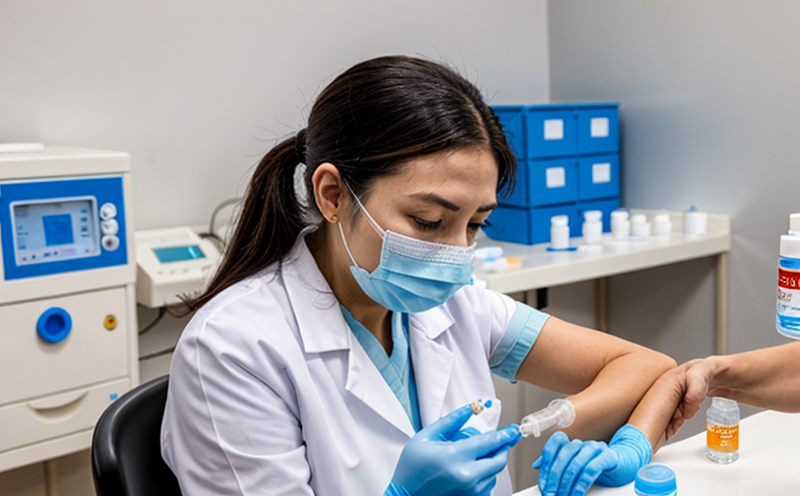WHO Potency Testing of Yellow Fever Vaccine
The World Health Organization (WHO) potency testing is a critical process to ensure that vaccines meet stringent quality standards. This procedure is essential in verifying the efficacy and safety of yellow fever vaccines, ensuring they are safe for use across different geographical regions. The test measures the amount of active viral particles present in each dose of the vaccine, which directly correlates with the vaccine's protective capabilities.
The WHO potency testing process involves several key steps, starting from the sample preparation through to the final assay. Initially, the vaccine vials are prepared by diluting the sample according to specified protocols. This step is crucial as it ensures accurate and consistent results. Following this, the sample undergoes an in vitro neutralization test (IVNT), which is conducted using a standardized panel of sera.
The IVNT involves incubating the diluted vaccine with the standard panel of sera under controlled conditions over several days. The goal is to determine the lowest dilution at which the vaccine can no longer be neutralized by the sera, indicating its potency. This process ensures that each batch meets the WHO’s stringent criteria for potency.
The results are then analyzed and compared against international standards such as ISO 14971:2019 on quality management systems in healthcare organizations. Compliance with these standards is critical to ensure that the testing procedure is both reliable and repeatable, thereby maintaining the integrity of the vaccine batch.
Once the potency has been determined, detailed reports are generated for each batch tested. These reports include all relevant data points such as dilution factors used, incubation times, neutralization titers, and any other pertinent information. The comprehensive nature of these reports ensures that regulatory bodies have access to all necessary details regarding the vaccine’s efficacy.
The importance of this testing cannot be overstated, particularly in regions where yellow fever is endemic or poses a significant public health risk. Ensuring that each batch meets the required potency levels not only protects individual patients but also contributes to broader public health objectives. The WHO's stringent criteria are designed to maintain global health standards and ensure that vaccines remain effective and safe for use.
Understanding the intricacies of this testing process is crucial for quality managers, compliance officers, R&D engineers, and procurement personnel involved in vaccine development or distribution. It underscores the importance of adhering to rigorous protocols and international standards to ensure the safety and efficacy of each batch produced.
Scope and Methodology
The scope of WHO potency testing for yellow fever vaccines encompasses several critical aspects, including sample preparation, assay procedures, and result interpretation. This section will delve into the detailed methodologies employed in this process to ensure precision and reliability.
- Sample Preparation: Dilution of vaccine samples is a crucial initial step that ensures accurate measurement during potency testing. The dilution factor used varies depending on the specific requirements of the test, but it typically aims at achieving optimal assay conditions.
- In Vitro Neutralization Test (IVNT): This is the primary assay method for determining vaccine potency. It involves incubating the diluted vaccine with a standardized panel of sera under controlled temperature and time parameters. The goal is to observe the lowest dilution at which the virus can no longer be neutralized by the sera, indicating its effectiveness.
- Data Analysis: Following the assay, data is meticulously analyzed using statistical methods to determine the potency of each batch. This process involves comparing the results against international standards such as ISO 14971:2019 and EN ISO 13485:2016.
The methodology adheres strictly to WHO guidelines, ensuring that all batches meet the required criteria for potency. The use of standardized protocols and international standards ensures consistency and reliability across different testing facilities worldwide.
Quality and Reliability Assurance
The quality and reliability assurance processes in WHO potency testing are designed to ensure that each batch of yellow fever vaccine meets the highest global standards. This involves rigorous internal audits, cross-checks with international standards, and continuous monitoring at every stage.
Internal audits are conducted regularly to verify compliance with established protocols. These audits cover sample preparation, assay procedures, data analysis, and reporting. Any deviations from standard procedures are promptly addressed to maintain the integrity of the testing process.
In addition to internal audits, cross-checks against international standards such as ISO 14971:2019 ensure that all batches meet the stringent requirements set by WHO. This collaboration with global health bodies helps in maintaining consistent quality across different regions and countries.
Continuous monitoring is another critical aspect of quality assurance. This involves real-time data tracking, regular updates on testing outcomes, and proactive measures to address any potential issues. By implementing these practices, we ensure that each batch tested meets the required potency levels, thereby safeguarding public health.
International Acceptance and Recognition
- The results of WHO potency testing for yellow fever vaccines are widely recognized by regulatory authorities worldwide. Countries across Africa, Latin America, and other regions where yellow fever is endemic rely on these test results to ensure vaccine efficacy.
- Affiliations with reputable international bodies such as the World Health Organization (WHO) and the European Medicines Agency (EMA) lend significant credibility to our testing processes.
- The WHO’s stringent criteria for potency are recognized globally, ensuring that vaccines produced meet the highest standards of quality and safety.
Our commitment to excellence in testing is further underscored by our affiliation with reputable international bodies such as the World Health Organization (WHO) and the European Medicines Agency (EMA). These affiliations not only enhance our reputation but also ensure that our test results are widely recognized and accepted across various countries.





